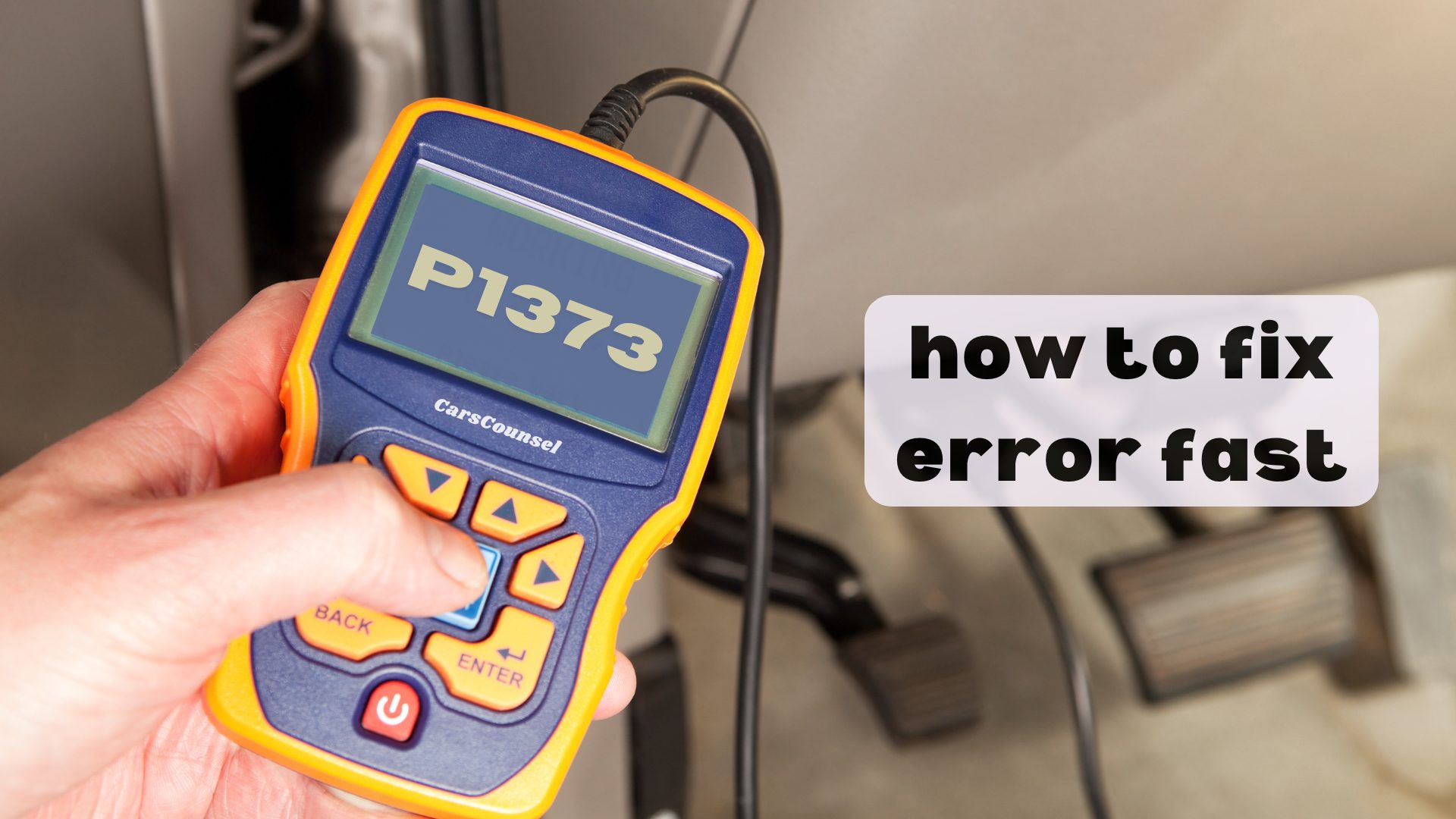It’s not uncommon for your vehicle to experience a minor hiccup, but when the check engine light comes on, it’s time to take notice. You’ve pulled the code and found that it’s P1373 – Ignition Coil Cylinder 3 Early Activation Fault.
This fault code indicates that there’s an issue with the ignition coil, but what exactly does that mean? Is it a simple fix or a more complex problem? As you start to investigate, you’ll want to know what causes this fault, how to identify the symptoms, and what steps to take to diagnose and repair the issue.

Quick Navigation
Key Takeaways
- The P1373 code indicates an early activation fault in the ignition coil for cylinder 3, affecting ignition timing and engine performance.
- A faulty ignition coil is the primary cause of the P1373 code, often malfunctioning and activating too early.
- Symptoms include rough idling, loss of power, engine misfires, poor engine performance, and increased fuel consumption.
- Diagnosing the issue involves using a scan tool to confirm the code, retrieving trouble code data, and performing a visual inspection of the ignition coil and wiring.
- Inspecting the ignition coil involves checking for signs of wear or damage, corrosion, or overheating, and verifying wire resistance using a multimeter.
Understanding Code P1373
When your vehicle’s onboard computer flags a P1373 code, it’s signaling an early activation fault in the ignition coil for cylinder 3.
This fault affects the ignition timing, disrupting the combustion process and leading to poor engine performance. The ignition coil is responsible for converting low voltage power into high voltage power to ignite the air-fuel mixture in the engine’s combustion chamber.
When the ignition coil for cylinder 3 activates too early, it can cause a lack of power, rough idling, and increased fuel consumption. If left unaddressed, this fault can lead to misfires, poor engine performance, and potentially even engine damage.
Understanding the P1373 code is vital to identifying and resolving the underlying issue to restore peak engine performance.
Common Causes of Fault
During routine engine operation, a faulty ignition coil is often the primary culprit behind the P1373 code, as it can malfunction and activate too early, disrupting the combustion process.
You’ll likely find that ignition coil failure is the root cause of the issue. However, other possible causes shouldn’t be overlooked.
Faulty spark plugs, for instance, can also contribute to the problem. Additionally, wiring or connection issues, engine control module (ECM) malfunction, and mechanical problems in cylinder 3 can also trigger the P1373 code.
It’s essential to identify the specific cause to guarantee an effective repair. By understanding the common causes of the fault, you can take the necessary steps to diagnose and fix the issue promptly, thereby certifying a successful outcome.
Identifying Symptoms
You’ve determined that the P1373 code is related to an early activation fault in the ignition coil for cylinder 3.
Now, it’s essential to identify the symptoms of this fault to understand its impact on your vehicle’s performance.
- Rough idling is a common symptom, as the misfire patterns can cause the engine to stumble or hesitate.
- You may notice a loss of power, especially when accelerating or climbing hills.
- Engine misfires can occur, leading to poor engine performance and decreased fuel efficiency.
- Increased fuel consumption is another symptom, as the engine struggles to maintain peak performance.
- In severe cases, engine stalling can occur, leaving you stranded on the side of the road.
Diagnosing the Issue
To accurately diagnose the P1373 code, you’ll need to employ a systematic approach that covers all potential causes. Begin by using a scan tool to confirm the code and identify the specific problem with the ignition coil in cylinder 3. This will give you valuable insights into the issue, such as when the fault occurs and how often it happens.
| Step | Action | Tip |
|---|---|---|
| 1 | Connect scan tool | Verify the tool is compatible with your vehicle’s make and model |
| 2 | Retrieve trouble code | Note the freeze frame data for further analysis |
| 3 | Check ignition theory | Review basic ignition principles to understand coil operation |
| 4 | Analyze scan tool data | Look for patterns or trends in the data to pinpoint the issue |
| 5 | Perform visual inspection | Check the ignition coil, wiring, and connections for damage or corrosion |
Inspecting Ignition Coil
With the scan tool data in hand, your attention turns to the ignition coil itself, a critical component in the ignition system.
Now it’s time to inspect the ignition coil for any signs of wear or damage. Take a close look at the coil condition, checking for cracks, corrosion, or signs of overheating.
- Check the coil’s electrical connections for corrosion or looseness
- Inspect the spark plug wire and boot for signs of wear or damage
- Look for any signs of ignition wear on the coil tower or spark plug electrode
- Check the coil’s mounting bracket for any signs of damage or corrosion
- Verify the coil’s wire resistance using a multimeter to guarantee it’s within specifications
Replacing Faulty Components
The faulty ignition coil, wiring, or connections must be replaced to resolve the P1373 code.
You’ll need to identify the specific faulty component and replace it with a new one. If the ignition coil is faulty, you’ll need to perform a Coil Replacement.
Make sure to disconnect the battery before starting the replacement process to avoid any accidental engine starts.
When replacing Faulty Wiring or connections, guarantee they’re securely fastened and not damaged.
Consult your vehicle’s repair manual for specific instructions on replacing these components.
Remember to clear the code after replacing the faulty components and test drive your vehicle to confirm the issue has been resolved.
Testing Ignition Coil Function
Most ignition coil failures can be detected by performing a simple test using a multimeter.
To test the ignition coil function, you’ll need to measure the coil resistance and perform spark testing.
- Measure the coil resistance using a multimeter set to ohms (Ω). Compare the reading to the manufacturer’s specifications.
- Check the coil’s primary and secondary resistance values.
- Perform a spark test using a spark tester to guarantee the coil is producing a strong spark.
- Check the spark plug wire for any signs of wear or damage.
- Verify the ignition coil is receiving the correct voltage from the ECM to guarantee proper function.
Clearing the Code
You’ve diagnosed the P1373 code and identified the faulty component; now it’s time to clear the code and guarantee the repair is successful.
To do this, you’ll need to use a scan tool to reset the code and verify the issue is resolved. Connect the scan tool to the vehicle’s onboard diagnostics (OBD-II) port and follow the manufacturer’s instructions to access the trouble code menu.
Select the “Clear Codes” or “Erase Codes” option to reset the P1373 code.
Once the code is cleared, test drive the vehicle to confirm the repair is successful and the code doesn’t reappear.
Repair Cost Estimates
After clearing the P1373 code, it’s vital to understand the estimated repair costs involved in fixing the ignition coil cylinder 3 early activation fault.
You’ll want to factor in labor rates, which can vary depending on your location, vehicle make and model, and engine type.
- Labor costs: $100-$250
- Parts costs: $50-$150
- Total estimated cost: $150-$400
- Insurance coverage: Check your policy to see if it covers repairs related to ignition coil faults
- Diagnostic time: 1-2 hours, depending on the complexity of the issue
Additional Resources
Several online resources are available to help you better understand and address the P1373 code, including factory service manuals and repair guides specific to your vehicle’s make and model. These resources can provide detailed instructions and diagrams to aid in diagnosis and repair.
| Resource | Description |
|---|---|
| Factory Service Manuals | Provides detailed repair information specific to your vehicle’s make and model |
| Repair Guides | Offers step-by-step instructions and diagrams for fixing the P1373 code |
| Online Forums | Allows you to connect with other vehicle owners who have experienced similar issues |
| Technical Service Bulletins | Provides information on known issues and recommended repairs from the manufacturer |
More OBD-II Codes
Frequently Asked Questions
Can a Faulty Oxygen Sensor Cause a P1373 Code to Appear?
You’re wondering if a faulty oxygen sensor can trigger a P1373 code. The answer is no, as a faulty O2 sensor affects sensor accuracy, not ignition timing, which is the primary cause of the P1373 code.
Will a P1373 Code Trigger the Check Engine Light Immediately?
As you fire up the engine, the ignition sequence unfolds like a choreographed dance, but a coil malfunction can throw off the rhythm, and yes, it’ll trigger the check engine light immediately, alerting you to the issue.
Is It Safe to Drive With a P1373 Code Without Risking Engine Damage?
When driving with an ignition system fault, you’re advised to exercise caution, as it can lead to engine damage. To minimize risks, avoid heavy loads, high speeds, and extreme temperatures, and have the issue addressed promptly to prevent further complications.
Can a Tune-Up or Spark Plug Replacement Fix a P1373 Code?
You may think a tune-up or spark plug replacement can fix the issue, but it’s unlikely to resolve the problem if the ignition coil is faulty or spark plug wires are damaged, requiring a more thorough diagnosis and repair.
Will a P1373 Code Clear Itself if the Issue Is Intermittent?
As you navigate the twists and turns of your engine’s performance, you wonder if an intermittent faulty ignition coil will miraculously heal itself, clearing the code like a fleeting storm cloud vanishing at dawn; unfortunately, it’s unlikely, and you’ll need to investigate and fix the root cause.
Conclusion
As you navigate the complex landscape of engine trouble, code P1373 serves as a landmark, guiding you toward the faulty ignition coil cylinder 3. Like a detective piecing together clues, you’ve unraveled the mystery, diagnosing the issue and pinpointing the source. Now, with the culprit exposed, you’re ready to strike, replacing the faulty component and reigniting your engine’s performance. With precision and accuracy, you’ll get your vehicle back on track, leaving the poor engine performance in the dust.

